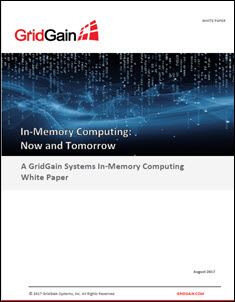The demand for in-memory computing (IMC) and new IMC platforms continues to grow. What’s pushing this growth as new products like the GridGain in-memory computing platform hit the market? A new white paper from GridGain Systems explores this topic and covers what’s next for IMC.

Download the full report.
As businesses everywhere struggle to keep up with – and strategically leverage – the massive amounts of data driving their organizations, more and more of them are turning to in-memory computing. The new GridGain white paper examines the factors contributing to this increased demand, the directions in which the in-memory computing industry is heading over the next decade, and how the Apache Ignite and the GridGain IMC platforms are on the cutting edge of the market.
IMC provides a different way to store and process data in RAM that is distributed across clusters of computers, the report explains.
And in-memory computing platforms are becoming the “method of choice” for today’s big-data and fast-data applications.
But what GridGain calls the “in-memory data revolution” is far from over. Growing demand is serving to boost innovation in IMC technologies.
GridGain narrows the key reasons behind the growing movement toward in-memory computing to three key factors:
- An explosion of data
- Heightened performance expectations
- In-memory data technology that keeps getting better and more afordable
According to the report, the cost of memory has dropped roughly 30 percent per year since the 1960s. And that affordability has served to drastically alter the storage paradigm.
“Instead of a disk-first architecture, with memory used more sparingly to cache small amounts of data for fast access, the data industry is evolving toward a memory first, disk second paradigm,” GridGain points out.
And as this paradigm shifts, in-memory technology is also evolving and becoming more capable.
So, what’s next for IMC? GridGain expects the market to experience several transformations over the next decade:
- Comprehensive in-memory computing platforms becoming systems of record
- First class support for in-memory SQL
- Growing artificial intelligence (AI) use cases for in-memory computing
- Non-volatile memory (NVM) as the preferred storage method
- Hybrid storage models for very large datasets
The new report also highlights the GridGain in-memory computing platform, which is the enterprise version of Apache Ignite. The solution is built on memory-based architecture, and works to solve today’s data needs with in-memory SQL support. And the optional hybrid storage architecture available in Apache Ignite and GridGain provides a flexible framework for easily adjusting a system’s mix of RAM, flash, and disk to support petabytes of data.
As a complete in-memory computing platform, GridGain users can consolidate on a single high performance, highly scalable solution for transactions and analytics, providing a lower TCO. Advanced SQL functionality and API-based support for common programming languages enable rapid deployment.
The future of in-memory computing is bright as businesses continue to explore how to cope with an explosion of data and users who expect real-time performance.
Download the new white paper, “In-Memory Computing: Now and Tomorrow,” to learn how Apache Ignite and GridGain are helping lead the way toward a vibrant in-memory future.



